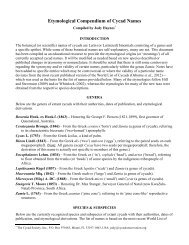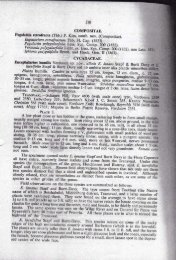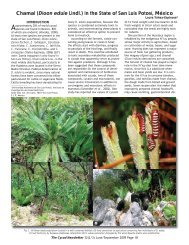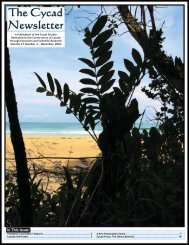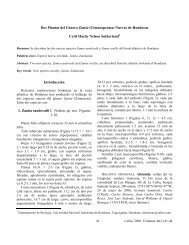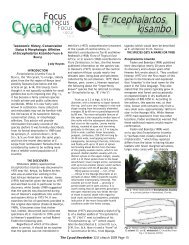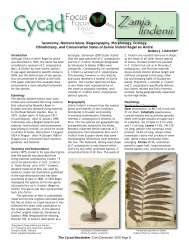In This Issue: - Cycad Society
In This Issue: - Cycad Society
In This Issue: - Cycad Society
You also want an ePaper? Increase the reach of your titles
YUMPU automatically turns print PDFs into web optimized ePapers that Google loves.
for commercial purposes� Localized<br />
application of certain growth regulators,<br />
such as Promaline (GA 4 /GA 7 + BA) has<br />
been shown to increase the number of<br />
shoots dramatically (Dehgan and Almira,<br />
1995)� <strong>This</strong> method has proven so<br />
successful with Z� floridana, C� revoluta<br />
, and several other less common species�<br />
As a consequence of branching induction<br />
and unusually rapid development of the<br />
caudex, young plants appear very large,<br />
reaching a size usually expected of 50or<br />
more year- old wild individuals�<br />
Although the primary intent of forced<br />
branching was conservation of rare and<br />
endangered plants for which seeds are<br />
generally unavailable, the method has<br />
shown considerable commercial<br />
potential� Additional studies are<br />
underway to further facilitate the<br />
practice�<br />
PLANTING AND MAINTENANCE: IRRIGATION AND<br />
FERTILIZATION<br />
It is a myth among nurserymen that<br />
most cycad species develop much too<br />
slowly for large scale production to be<br />
economically feasible� Admittedly some<br />
cycads are slow to develop and usually<br />
even much slower in reaching<br />
reproductive maturity� Stem growth is<br />
primarily dependent on annual leaf<br />
production, and in turn leaf development<br />
and elongation appears to be directly<br />
related to healthy root growth�<br />
Therefore, it follows that stimulating<br />
good root development would directly<br />
impact the plant growth� For plants to<br />
grow quickly and in good health, the soil<br />
mix must be well-drained, have an<br />
optimal pH and nutrient balance, and be<br />
kept sufficiently moist to meet the needs<br />
of the plant, but not so much as to create<br />
anaerobic conditions� <strong>In</strong> terms of large<br />
scale production in containers, one can<br />
only discuss watering and fertilization in<br />
relation to the soil mix� It has been<br />
pointed out that growth of cycads is<br />
negatively affected by severe reduction<br />
in soil moisture (Dehgan, 1983)� Under<br />
cultivation, however, too frequent<br />
irrigation, as opposed to dryness, is often<br />
the problem that results in reduced soil<br />
oxygen and directly affects nutrient<br />
uptake and utilization�<br />
Our soil mix recommendations of the<br />
past (Dehgan, 1983; Dehgan and Almira,<br />
1993) made a distinction between species<br />
of the mesic and xeric habitats� While<br />
the basic principles upon which this<br />
division was based remain viable, some<br />
changes have become necessary to lower<br />
the weight of the soil mix and its cost�<br />
The following soil mix is recommended<br />
for all species, but with serious<br />
consideration given to their native<br />
habitat� Soil moisture should be primarily<br />
controlled by irrigation frequency rather<br />
than water-holding capacity of the soil<br />
mix� Thus, plants of the more mesic<br />
habitats, such as most species of Zamia,<br />
some Ceratozamia spp�, Bowenia spp�,<br />
Cycas spp�, Microcycas calocoma,<br />
Macrozamia spp�, Lepidozamia spp�, and<br />
Stangeria eriopus� (Kunze) Baillon,<br />
require more frequent irrigation and a<br />
higher soil moisture than species of the<br />
more xeric habitats, such as Z�<br />
furfuracea, Encephalartos spp�, Dioon<br />
spp�, and somesome Ceratozamia<br />
species� A typical soil mix should have<br />
equal parts by volume of peat moss +<br />
sharp sand + perlite + pine bark, to which<br />
should be added 2�25 kg/M 3 (51b/yd 3 ) of<br />
dolomite and 1�25 kg/M 3 (3lb/yd 3 ) perk<br />
micronutrients�<br />
Experience indicates that plants grown<br />
in acid soils (pH < 6�5) usually perform<br />
poorly� For example, Dehgan et al� (1994)<br />
recently noted that such problems as<br />
“frizzle top” (similar to that of palms)<br />
and micronutrient (specifically Mn,)<br />
deficiencies are indirectly caused by low<br />
soil pH� For best results the optimal soil<br />
pH should be 6�5 to 7�0, hence addition<br />
of dolomite� <strong>In</strong> general, except in acid<br />
soils, micronutrient deficiencies can be<br />
corrected with addition of micronutrients<br />
or application of “complete fertilizers”�<br />
Availability of micronutrient-amended<br />
slow release fertilizers have made<br />
possible maintenance of a consistent,<br />
reasonable level of fertility in the soil<br />
for relatively long periods of time and<br />
avoidance of too frequent fertilization<br />
(Dehgan and Almira, unpublished data)�<br />
However, a direct correlation between<br />
fertilizer amounts and shade levels has<br />
been shown by Keever and Cobb (1986)<br />
for Z� furfuracea and subsequently<br />
confirmed by Dehgan and Almira<br />
(unpublished data) for Z� floridana, Cycas<br />
revoluta, C� taitungensis C� F� Shen et<br />
al� (= Z� taiwaniana Carruth�), and other<br />
species� Higher growth rate and<br />
substantial increase in leaf number were<br />
observed in 30-50% shade and weekly<br />
application of liquid fertilizer at 200 to<br />
300 ppm� Shading greater than 50%<br />
results in abnormally long, spindly leaves�<br />
The <strong>Cycad</strong> Newsletter Page 12<br />
CONCLUSIONS<br />
The recent escalation of interest in<br />
cycads by botanical scientists,<br />
professional nurserymen, and amateur<br />
collectors has contributed to both a<br />
greater appreciation of and<br />
endangerment to cycads� Several notable<br />
private collections around the world are<br />
of considerable significance in terms of<br />
germplasm availability, but the demand<br />
for plants has far exceeded the supply,<br />
resulting in decimation of many cycad<br />
populations� We can no longer allow<br />
wholesale destruction of these<br />
magnificent ancient plants� It befalls to<br />
horticulturists and nurserymen to<br />
produce superior plants so as to prevent<br />
plant poaching� Such an endeavor is<br />
possible only through horticultural<br />
research� It is a certainty that, despite<br />
the efforts of CITES and some<br />
governmental agencies, decimation of<br />
wild populations will continue as long as<br />
the demand for these valuable plants is<br />
not met through horticultural production�<br />
Research results of the past two decades<br />
have encouraged commercial production<br />
of cycads, which in concert with the<br />
<strong>Cycad</strong> Specialist Group of the IUCN and<br />
positive actions of CITES and concerned<br />
individuals has significantly frustrated,<br />
though by no means prevented, the<br />
pilfering of natural cycad populations�<br />
Literature Cited<br />
Butt, L� P� 1990� An introduction to the<br />
genus Cycas in Australia� Publication<br />
Fund, Palm & <strong>Cycad</strong> Societies of<br />
Australia�<br />
Chavez, V� M�, R� E� Litz, P� A� Moon, and<br />
K�J� Norstog� 1992� Somatic<br />
embryogenesis from leaf callus of<br />
mature plants of the gymnosperm<br />
Ceratozamia mexicana var� robusta<br />
(Miq�) Dyer (<strong>Cycad</strong>ales)� <strong>In</strong> Vitro Cell�<br />
Develop� Biol� Plant 28: 59-63�<br />
Crosiers, C� and F� P� Malaisse� 1995� Exsitu<br />
pollination and multiplication of<br />
Encephalartos laurentianus Dewild<br />
(Zamiaceae-<strong>Cycad</strong>ales)� Biodivers�<br />
Conserve� 4: 767-775�<br />
Dehgan, B� 1983� Propagation and<br />
growth of cycads - a conservation<br />
strategy� Proc� Fla� State Hort� Soc�<br />
96: 137-139�<br />
Dehgan, B� 1995� The Few, The Proud,<br />
the <strong>Cycad</strong>s� Part I� Morphology and



